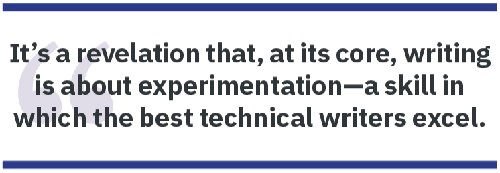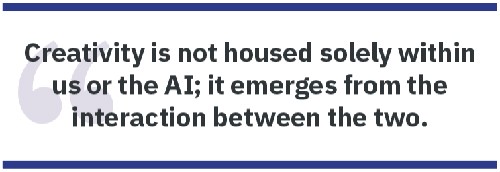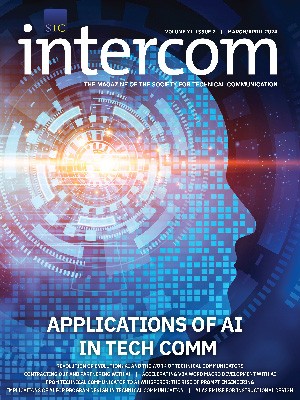By Scott Abel | Fellow
 In this installment of “Meet the Change Agents,” I sit down with Lance Cummings, an innovative educator in the Professional Writing program at the University of North Carolina Wilmington (UNCW), to discuss the artificial intelligence (AI) revolution and its impact on the way writers write technical documentation and instructors teach technical writing students. Cummings infuses his courses with research about diverse technological and linguistic applications, using real-world examples to encourage the creative adoption of AI technologies.
In this installment of “Meet the Change Agents,” I sit down with Lance Cummings, an innovative educator in the Professional Writing program at the University of North Carolina Wilmington (UNCW), to discuss the artificial intelligence (AI) revolution and its impact on the way writers write technical documentation and instructors teach technical writing students. Cummings infuses his courses with research about diverse technological and linguistic applications, using real-world examples to encourage the creative adoption of AI technologies.
Scott: There’s much to learn about applying AI to technical documentation. But before we dive into the deep end of generative AI (genAI), tell us a little about yourself and your connection to technical communication.
Lance: At UNCW, my role as an educator and researcher spans a broad spectrum of professional writing, including technical communication, business writing, science writing, and digital writing. My fascination with technical communication took root while exploring writing communities within multinational corporations. This journey led me to forge valuable partnerships with companies both in North Carolina and internationally in Kraków, Poland.
The connection to Kraków might appear unconventional initially, but I spent much time there as an undergraduate and wanted to create a similar experience for my students at UNCW. Around 2018, I discovered a dynamic tech writing community in Kraków. Recognizing this as a golden opportunity to expose students to global aspects of technical communication, I developed a study abroad program focused on Poland, aiming to immerse students in the realm of content development and to uncover how cultural nuances subtly influence collaborative writing processes.
Many students commonly misunderstand the nature of technical writing, perceiving it as abstract and elusive. I believe in dismantling this mystique by bringing the workplace into the classroom. By exposing students to actual workplace environments and integrating practical experiences into their learning, I want to provide a concrete understanding of technical communication.
This approach demystifies the field and sparks curiosity about the intricacies of workflows, collaboration, and structured content. These are the pillars of what I like to term “content and information development”—a crucial aspect of technical communication that goes beyond mere writing to encompass the creation and management of information in an efficient and impactful way.
My goal has been not only to educate but also to inspire. By connecting students with real-world applications and global perspectives, I aim to broaden their horizons and equip them with the skills and insights to excel in the evolving landscape of professional writing.
Scott: There’s much interest in genAI. And I know you’re sincerely interested in determining how to best use AI tools in the education process. Can you describe your current research interests and how they relate to the use of generative AI in education?
Lance: My initial encounter with genAI dates back to 2021, during my research into the creator economy. The creator economy is where writers create content directly online for audiences, many of whom now make a living doing it (especially since COVID). The potential of genAI immediately struck me. The capabilities hinted at a future where genAI would be integral to our creative and professional lives. Recognizing this imminent shift, I wanted to understand how to harness genAI in writing.
This exploration was not just academic—it involved hands-on experimentation with genAI in various forms of writing, from poetry and course materials to blogs.
Just a week after I introduced AI to my students, the turning point came with the release of ChatGPT. This development brought a new dimension to our understanding and use of AI in writing.
For me, writing transcends the mere generation of text. It’s an activity deeply embedded within networks of people, places, and things, making each writing process and workflow uniquely fascinating. Understanding how genAI fits into these ecosystems seems like a natural next step.
I always emphasize to my students that there is not just one way to write; similarly, the use of AI in writing is not monolithic or static. This rich diversity in approaches and applications fuels my passion for teaching and researching writing, whether AI is involved or not.
My approach to education has also been about fostering a mindset rather than imparting a set formula. I tell my students that I’m not just teaching them how to write but how to think like writers. Writing is about solving complex problems, managing intricate projects, and collaborating with diverse groups. These are the skills I want my students to master—the ability to think critically and creatively, not to just produce text. I believe the educational system has long needed this shift from content-focused learning to problem-solving, and genAI’s arrival only amplifies this necessity.
My insights are also shaped by my experiences in technical communication, mainly through my involvement in Europe’s premier content conference, soap!, in Kraków. It’s become increasingly evident that the term “technical writer” no longer fully encapsulates the multifaceted roles of content specialists. Technical writing is about being an integral part of a network—involving people, places, and things. Human insight and intervention have become crucial in a world increasingly intertwined with AI. Technical communicators are the essential human element in this loop.

Tech writers are far more than mere text generators or copy editors. They are adaptability experts, skilled in navigating and influencing workflows, making a tangible difference in how tasks are accomplished, particularly in times of change. Managing content is about managing change. And who better to steer this change than technical communicators? Their adaptability and ability to think about workflows uniquely position them to work and capitalize on the dynamic landscape shaped by genAI.
Scott: What potential do you see in generative AI for transforming how technical writing is taught and practiced?
Lance: The advent of generative AI marks a pivotal moment in the evolution of technical writing, akin to the revolutionary impact of computers on the field. Recognizing this, I’ve proposed a new course at UNCW, named ENG 326 Writing with AI, designed to align with the multifaceted nature of information and content development. This course isn’t just about teaching students to generate text; it’s an immersive journey into the complexities of the writing process, encompassing:
- Knowledge Management: Understanding and organizing information effectively.
- Project Management: Overseeing the writing process from conception to completion.
- Organization: Structuring content logically and coherently.
- Content Delivery: Tailoring messages for different platforms and audiences.
- Managing Style: Developing a unique voice while adhering to guidelines.
- Optimizing Workflows: Streamlining the writing process for efficiency.
- User Testing and Audience Analysis: Gauging audience response and adjusting content accordingly.
These elements are integral to the transformative power of AI in writing. Just as creators have recognized and adapted to this shift, embracing AI as early adopters, our approach to education must also evolve. Creators view writing through the lens of the “creator flywheel,” a cyclical process involving ideating, testing ideas online, further developing them, and retesting them. This approach is not a linear process but a dynamic, iterative one that encourages innovation and refinement.
Reflecting on this paradigm shift, I have restructured all my writing classes, including ENG 101, around this workflow-centric approach. Students engage in a continuous cycle of writing short essays (ideation), posting them on platforms like Substack for feedback (testing), refining their ideas (development), and ultimately crafting a focused, longer piece (final test). This methodology has reinvigorated students’ passion for writing and instilled a more profound understanding that writing transcends mere text generation.
Interestingly, I’ve observed a trend where, by the end of the course, students tend to either use AI less or employ it in more targeted, thoughtful ways. This shift occurs as they appreciate the nuances missing when AI dominates the writing process. It’s a revelation that, at its core, writing is about experimentation—a skill in which the best technical writers excel.
My overarching aim is to nurture this experimental, exploratory mindset in the classroom, echoing what I believe should also be our collective approach in the professional sphere. The potential of generative AI in technical writing is not just about harnessing a new tool, but also about reimagining and redefining our processes, creativity, and engagement with content. It’s about preparing for a future where AI is an integral partner in our writing workflows, enhancing our capabilities and opening new avenues for innovation and efficiency.

Scott: How do you envision generative AI tools augmenting the workflow of technical writers?
Lance: When considering the impact of generative AI on technical writing, it’s helpful to view it through the lens of rhetoric, an ancient practice focusing on persuasion and communication. The ancient Greeks and Romans categorized the creative process into five canons: Invention, Organization, Style, Delivery, and Memory.
Initially, these rhetorical canons focused primarily on oratory, as public speaking was the primary form of “content” in ancient times. However, with the advent of the printing press, the emphasis shifted toward writing and publishing, marking a new era where the written word became the dominant mode of communication.
The emergence of computers and Web 2.0 further shifted the focus to digital writing, expanding how we think about content to include digital platforms and multimedia. This evolution created new challenges and opportunities in how we create, organize, and deliver content.
With the advent of AI, we are on the cusp of another significant shift—this time towards content and information development. AI compels us to rethink the ancient canons of rhetoric in the context of modern technology. It’s no longer just about crafting speeches or writing texts; it’s about developing dynamic, interactive content tailored to diverse digital platforms.
AI influences every aspect of this development process:
- Invention: AI provides many ideas, enhancing brainstorming and creative thinking in content development.
- Organization: AI aids in structuring complex digital content, making it more accessible and coherent.
- Style: AI ensures consistency and adaptability in the diverse styles required for digital platforms.
- Delivery: AI transforms how content is distributed across various digital mediums, optimizing for engagement and reach.
- Memory: AI is a vast repository, supporting content creation with extensive data and historical insights.
These advancements in AI allow technical writers to increase their productivity, focusing more on the creative and complex aspects of their work, such as tailoring content to specific audiences and ensuring clarity and accuracy. In this new era, AI doesn’t just change our tools; it redefines our communication and content creation approach. The canons of rhetoric evolve from their classical origins to become foundational elements in content and information development, shaped and enhanced by AI’s capabilities.
Scott: Would you share some examples of genAI tools that have impressed you with their capabilities in technical writing contexts?
Lance: I’m honestly not sure tech writers need more than ChatGPT and the suite of writing and project management tools you already use. The reason is simple: most AI tools are essentially “ChatGPT wrappers”—they repurpose ChatGPT within different interfaces. With proficient use of ChatGPT, you can accomplish many tasks independently. It is also likely that almost every tool you are using now will integrate an AI component, reflecting the growing ubiquity of this technology.
For tech writers who may not yet have access to ChatGPT in their workplaces, I strongly recommend exploring it independently. Familiarity with ChatGPT can be invaluable when it becomes a standard part of the technical writing toolkit, which I believe will be 100% eventually.
Understanding how to integrate it effectively into your workflow is crucial. I recommend that technical writers consider temporarily subscribing to ChatGPT Plus. It offers a powerful combination of analyzing documents, creating images, searching the web, using plugins, and building chatbots in one platform.
However, the realm of generative AI tools is vast and constantly evolving. My preference is toward tools that allow users to customize AI responses within their workflow. AI will shape, not just our writing, but how we think. We need to learn how to shape the technology.
Some tools that I currently incorporate into my content workflow:
- Lazy AI: This knowledge management tool integrates AI to automate tagging, content generation, and task management tasks. Its crucial feature is invoking AI anywhere with a keyboard shortcut, allowing for seamless integration into your workflow. Most importantly, it lets you write and store your custom prompts, offering a high degree of personalization.
- Triplo AI: Similar to Lazy AI, Triplo AI offers the convenience of accessing AI across your desktop, using your custom prompts. Its unique feature is the ability to combine individual prompt blocks rapidly, facilitating quick and context-sensitive AI interactions.
- Gamma AI: Gamma AI enhances an already robust app for presentations, documents, and websites by integrating generative AI. The structured nature of the core app, Gamma, lends itself well to the AI’s ability to effectively generate slides, images, and content.
- Lex Page: Think of it as Google Docs but augmented with a potent AI assistant. It allows for a dynamic interaction with AI, whether you’re working on your text, generating new content, or seeking AI-powered insights on your document.
- Elicit AI: This tool searches scientific literature and provides citations and synthesized paragraphs. I find that the results are better than those of our library search engine.
- Zapier: I’ve used this to create chatbots specifically trained for my classes. You can also incorporate them into other automation workflows. Though you can technically do this now with ChatGPT, Zapier is a free way to give access to non-ChatGPT Plus users.
The key takeaway is that the innovation lies not in the AI technology itself—as all these tools function on the same principles as ChatGPT—but in the workflow integration. These tools excel in placing AI where it’s most needed—in the context of your work. They empower us to shape the AI outputs through custom prompts or by interacting directly with AI about our data. As writers, our role is pivotal in shaping these tools, steering their development beyond the confines of purely technical or engineering perspectives.
Scott: What are some common misconceptions about genAI that you encounter among your students?
Lance: One of the biggest misconceptions I encounter among students is the belief that AI possesses a form of knowing or understanding akin to human cognition. While AI demonstrates a type of “knowing” in computational terms, it doesn’t align with the human-centric understanding of these concepts. While AI is a potent tool, it cannot substitute the critical thinking, expertise, and creativity that human writers bring.
Students sometimes overestimate the accuracy and appropriateness of AI-generated content, not realizing the importance of critical evaluation and human oversight.
They also tend to have “AI goggles.” The first rush of seeing AI output can seem like magic. It looks “good enough” even when it is just a “sloppy” use of AI. Students don’t often realize how easy it is to spot sloppy use of AI. Students often accept AI outputs at face value, particularly for assignments they’re less invested in, which can be problematic.
I’ve also heard concerns from students about AI being “evil,” not necessarily in ethical terms, but in the sense that it is taking jobs and altering our culture. While I don’t dismiss the potential disruptions AI could cause, I also see its immense potential for good, especially when strategically incorporated into the writing process. The challenge lies in the common misunderstanding of writing as a task rather than a process.
That’s why we must teach AI regarding workflow, not just as a way to generate text. In understanding writing as a networked process, students can see AI as a collaborative tool that enhances their work, not something that overtakes it. By the end of my courses, students often see the positive aspects of AI, learning to use it intelligently to augment their creativity and efficiency rather than replacing their unique human capabilities.
This shift in understanding is critical. It’s about recognizing AI as a partner in the creative process, a tool that can extend human abilities rather than supplant them. Teaching AI in this context demystifies the technology and empowers students to leverage its capabilities effectively. The goal is for students to leave with a nuanced understanding of AI’s role in writing, equipped to use it to their advantage in our evolving digital world.
Scott: What common misconceptions about generative AI do you encounter among teaching professionals?
Lance: One prevalent misconception among teachers is that AI is plagiarism. This perspective stems from a misunderstanding of how generative AI technology operates. Just as we process and verbalize information based on the data we absorb daily, Large Language Models (LLMs) synthesize vast amounts of data in a similar but way more expansive manner. It’s not about cutting and pasting existing work; it’s a complex data assimilation and output process. The ethical debate should be more nuanced, focusing on how these companies acquire and continue to access this data. Knowing when to cite ChatGPT is just like citing our knowledge; it is more complex than just blanketing it all with plagiarism.
Another common misperception is that AI lacks creativity or the ability to generate new ideas, leading to concerns about losing one’s voice or authenticity in AI-assisted work. Creativity is not housed solely within us or the AI; it emerges from the interaction between the two. I’m fond of the term “Cyborgs Writing.” Any work I produce with AI is a collaboration—part human, part machine. It’s a unique creation that wouldn’t exist without both elements.

This interview is a prime example of pushing the boundaries of AI collaboration. Let me walk you through how I’ve been answering these questions:
- I began by having ChatGPT scour my website to construct a base understanding of who I am.
- I then fed these interview questions to ChatGPT, asking it to draft responses based on my writings on Substack.
- I wrote my answers independently and quickly without reviewing the AI’s initial responses.
- Finally, I presented ChatGPT with my responses, instructing it to merge them with its own into well-crafted, cohesive sections.
You might argue otherwise, but I believe this process works well. It’s a cyborg effort in every sense, blending human insight with AI’s capabilities.
Fears that AI will take over our jobs, whether we are tech writers or teachers, abound. Some teachers believe that AI could render traditional teaching methods obsolete. However, we should view AI as an extension of our expertise rather than a replacement. It’s a tool that enhances, not diminishes, our teaching methodologies. Far from making educators redundant, AI opens new avenues for teaching and learning.
Scott: What are the most significant challenges when integrating generative AI into the technical writing curriculum?
Lance: One major challenge is access to technology. In places like North Carolina, getting new research or student-use software is challenging due to bureaucratic hurdles despite available funding. I’ve often had to build relationships with developers and startups to get my students free access to real-world tools.
Another challenge is preventing the sloppy use of AI. While I’m open to using AI, there’s always a risk that students might rely on it too much. AI offers tremendous potential for aiding the writing process, but it’s not a panacea for effort and thoughtful engagement. Educators need to design assignments with real-world relevance and impact to ensure students use AI responsibly.
When students write for actual audiences or work on projects for clients, they’re more invested in the quality of their output. This approach lessens the likelihood of students relying too heavily on AI, encouraging them to integrate the technology more thoughtfully into their work. The goal is to strike a balance, using AI to enhance, not replace, the student’s writing and analytical skills.
Knowledge management isn’t new, but academia is poor at teaching it. Figuring out how to incorporate this into classes in an understandable way will be a challenge. Being a successful writer has always meant managing your knowledge. AI makes this doubly important.
And the challenge will be what it has always been. It is getting students to write and to care about writing. We need to show them that AI isn’t going to kill writing. It is going to make it even more critical to get it right.
Perhaps the best aspect of AI is the power of content reuse. You can’t use AI to repurpose content if you haven’t written any.
Scott: When teaching technical writing, how do you address the ethical considerations and potential biases inherent in generative AI?
Lance: Addressing the ethical considerations and potential biases in generative AI is critical to teaching technical writing.
One practical approach involves AI in the classroom, engaging students directly with AI outputs. This hands-on experience is invaluable, primarily when AI produces incorrect or biased information during a demo. Such instances become teachable moments, illustrating the need for critical analysis and ethical consideration in technical writing.
Writing classes inherently intertwine with reading. An intelligent writer must first be a discerning reader. Analyzing AI outputs with the same rigor applied to any text is crucial. In my experience, some of the most enlightening classroom discussions have emerged when examining the flaws and biases in AI-generated content. It’s a powerful way to reinforce the importance of critical thinking in writing.
Students are naturally critical, particularly when reviewing work that is not their own or that of a peer. While peer reviews can sometimes devolve into superficial niceties, presenting students with AI-generated text elicits more candid and critical responses. This dynamic serves as an excellent tool for honing their analytical skills.
Data security is another significant concern. In my classes, we adopt a cautious approach, reframing AI as an opportunity to engage with technology safely and responsibly. I neither compel students to use AI nor to upload their work into questionable systems.
We conduct most of our writing activities online, creating a safer environment for students to experiment with AI. I tell my students not to put anything in AI that they wouldn’t post on the internet. We post everything on the internet, so they already have this mindset.
Perhaps a broader perspective on this issue would be to ask, “How do you address the ethical considerations and potential biases inherent in teaching the information and content development process?” It’s essential to recognize that biases and ethical challenges are not exclusive to AI. They can permeate various aspects of the writing process. By incorporating these discussions into our curriculum, we educate students about AI and the broader ethical landscape of technical writing.
Scott: What skills should technical writers develop to leverage generative AI effectively?
Lance: Technical writers must continue enhancing their ability to solve complex problems, manage intricate projects, and effectively collaborate within diverse groups. In other words, think in terms of people, processes, and things, not simply in terms of content. If you understand writing through a content operations lens, you’ll better understand how AI functions within those frameworks.
Developing a solid understanding of structured content and knowledge management is perhaps vital. As AI technology grows, we will emphasize the need to produce semantically-enhanced structured content.
A deep understanding of advanced content production methods is becoming increasingly vital in the “AI Content Operations” process. In the past, I advised students that all writers should have a basic understanding of coding. While this remains true, it’s now just as important for writers to understand knowledge management.
Prompt operations are a good example. By adopting a modular mindset, technical writers can manage AI prompts more effectively as a team. This approach involves breaking down content into smaller, self-contained pieces, much like Lego blocks, which can be combined in various ways to address different needs.
Understanding the interrelationships between these prompt blocks is crucial, as it allows for developing a well-managed prompt system that reflects the desired content structure and flow. But this isn’t just about working with prompts. It’s about working with people, technology, and systems.
To thrive in an AI-integrated technical writing environment, writers must blend their traditional skills with an understanding of structured content, knowledge management, and collaboration. This combination will enable them to create efficient, adaptable, high-quality content in collaboration with AI technologies.
Scott: How do you foresee generative AI influencing the future of technical communication and content strategy?
Lance: Generative AI will enable more efficient and dynamic content creation, allowing technical writers to focus on complex problem-solving and creative aspects of content development. It’s essential to understand writing as a collaborative workflow, not just involving people but also involving machines.
AI’s ability to process vast amounts of data will lead to more personalized and contextually relevant content, enabling real-time content optimization and audience targeting. As AI tools advance, they will offer predictive insights that help shape content strategies more aligned with audience needs and behaviors. However, the human element will remain crucial for overseeing AI’s outputs, ensuring accuracy, and infusing creativity and empathy into content.
Understanding your audience and the role of rhetoric is crucial to managing content. Yes, AI can do phenomenal things with data, especially when understanding audiences and users. But that will always be incomplete without human understanding. Put the two together, and you have a robust content strategy.
Generative AI will be a powerful tool for technical communicators, enhancing efficiency, precision, and relevance in content strategy while relying on human expertise for guidance and contextual understanding.
Scott: What advice would you give to technical writers who are skeptical about the role of AI in their field?
Lance: For technical writers who are skeptical about AI, my advice is to dive into experimentation. The potential of AI in our field is vast, often beyond what we initially imagined. Collaboration in experimentation is key. Just as the best writing often comes from teamwork, the most effective AI applications, like prompts or bots, are usually the result of collaborative efforts.
Not feeling overwhelmed by the plethora of apps and technology is essential. There’s no need to fear missing out. Starting with tools like ChatGPT is sufficient. While exploring other tools can be beneficial, don’t feel pressured to use them. Your focus should be on understanding and leveraging AI to enhance your writing and content strategy, not using every available tool.
Don’t get sucked in by AI experts. It comes down to this: How does AI fit best into your workflow and network of people, processes, and things? Only you and your team can figure that one out.
Scott: How can educators ensure their students critically engage with and become proficient in generative AI?
Lance: Like writers, educators shouldn’t fear AI, but must use it carefully. It’s hard work to create content with AI. You must still write, manage content, and build suitable systems. It’s essential to be creative and thoughtful with technology.
Again, I can’t stress enough that this should be a collaborative effort. We shouldn’t hoard AI knowledge, because it will be our secret to success. We also shouldn’t be ashamed about using AI in our writing. We should be using it openly and thoughtfully.
I suppose that’s why my most significant advice is to experiment with AI in the classroom with your students. I love it when AI demos go off the rails, or something weird happens, because you can discuss it in class. Students also need to see when it works right, which can be eye-opening.
Scott: Finally, what steps can the broader educational community take to prepare for the increasing integration of AI in technical writing and education?
Lance: To navigate the integration of AI in our educational landscape, especially in technical writing, we must approach this as a collective journey of adaptation and learning. The key lies in introducing AI technologies into our classrooms and ensuring that we do these introductions equitably and responsibly. Both students and teachers need safe, equitable access to these tools and continuous AI literacy training, empowering every individual in the educational process with the knowledge and skills to effectively use AI.
Teachers at all levels are notoriously under-resourced, and the speed at which AI develops puts most at a distinct disadvantage. While I think educational institutions need to invest quickly on this front, that’s not usually what happens. So, I recommend that teachers learn how to leverage AI to make their jobs easier first. Doing so will give them experience incorporating AI into their workflow and time to focus on what matters to them or to keep up with the AI world.
As educators, we are responsible for staying abreast of emerging AI technologies, understanding how they evolve, and leveraging them in educational contexts. It’s about creating an environment where AI is not just a part of the curriculum but a dynamic, integrated component of learning and creativity. We can only do that by engaging with the technology on multiple levels.
While it is essential to keep an eye on ethical considerations, it is equally important that we take a practical and experimental approach that helps us understand this technology in the networks around us. I believe this is all true for tech writers. And why most of my work focuses on taking practical approaches to AI that seek to understand its role in a complicated network of relationships between people, processes, and things.
You can follow these musings at: http://www.isophist.com
Scott: Thanks for sharing your wisdom and experience with Intercom readers, Lance. We appreciate you making time to help us better understand the world of generative AI and technical documentation education and practice. I appreciate your dedication to the craft and willingness to share your lessons with others.
 In the digital age, change happens quickly. This column features interviews with the movers and shakers—the folks behind new ideas, standards, methods, products, and amazing technologies that are changing the way we live and interact in our modern world. Got questions, suggestions, or feedback? Email them to scottabel@mac.com.
In the digital age, change happens quickly. This column features interviews with the movers and shakers—the folks behind new ideas, standards, methods, products, and amazing technologies that are changing the way we live and interact in our modern world. Got questions, suggestions, or feedback? Email them to scottabel@mac.com.


